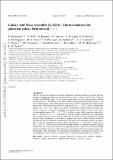Galaxy And Mass Assembly (GAMA) : the mechanisms for quiescent galaxy formation at z < 1
Abstract
One key problem in astrophysics is understanding how and why galaxies switch off their star formation, building the quiescent population that we observe in the local Universe. From the GAMA and VIPERS surveys, we use spectroscopic indices to select quiescent and candidate transition galaxies. We identify potentially rapidly transitioning post-starburst galaxies, and slower transitioning green-valley galaxies. Over the last 8 Gyrs the quiescent population has grown more slowly in number density at high masses (M∗>1011M⊙) than at intermediate masses (M∗>1010.6M⊙). There is evolution in both the post-starburst and green valley stellar mass functions, consistent with higher mass galaxies quenching at earlier cosmic times. At intermediate masses (M∗>1010.6M⊙) we find a green valley transition timescale of 2.6 Gyr. Alternatively, at z∼0.7 the entire growth rate could be explained by fast-quenching post-starburst galaxies, with a visibility timescale of 0.5 Gyr. At lower redshift, the number density of post-starbursts is so low that an unphysically short visibility window would be required for them to contribute significantly to the quiescent population growth. The importance of the fast-quenching route may rapidly diminish at z<1. However, at high masses (M∗>1011M⊙), there is tension between the large number of candidate transition galaxies compared to the slow growth of the quiescent population. This could be resolved if not all high mass post-starburst and green-valley galaxies are transitioning from star-forming to quiescent, for example if they rejuvenate out of the quiescent population following the accretion of gas and triggering of star formation, or if they fail to completely quench their star formation.
Citation
Rowlands , K , Wild , V , Bourne , N , Bremer , M , Brough , S , Driver , S P , Hopkins , A M , Owers , M S , Phillipps , S , Pimbblet , K , Sansom , A E , Wang , L , Alpaslan , M , Bland-Hawthorn , J , Colless , M , Holwerda , B W & Taylor , E N 2018 , ' Galaxy And Mass Assembly (GAMA) : the mechanisms for quiescent galaxy formation at z < 1 ' , Monthly Notices of the Royal Astronomical Society , vol. 473 , no. 1 , pp. 1168-1185 . https://doi.org/10.1093/mnras/stx1903
Publication
Monthly Notices of the Royal Astronomical Society
Status
Peer reviewed
ISSN
0035-8711Type
Journal article
Collections
Items in the St Andrews Research Repository are protected by copyright, with all rights reserved, unless otherwise indicated.
Related items
Showing items related by title, author, creator and subject.
-
SDSS-IV MaNGA: How the stellar populations of passive central galaxies depend on stellar and halo mass
Oyarzún, Grecco A.; Bundy, Kevin; Westfall, Kyle B.; Tinker, Jeremy L.; Belfiore, Francesco; Argudo-Fernández, Maria; Zheng, Zheng; Conroy, Charlie; Masters, Karen L.; Wake, David; Law, David R.; McDermid, Richard M.; Aragón-Salamanca, Alfonso; Parikh, Taniya; Yan, Renbin; Bershady, Matthew; Sánchez, Sebastián F.; Andrews, Brett H.; Fernández-Trincado, José G.; Lane, Richard R.; Bizyaev, D.; Boardman, Nicholas Fraser; Lacerna, Ivan; Brownstein, J. R.; Drory, Niv; Zhang, Kai (2022-07-06) - Journal articleWe analyze spatially resolved and co-added SDSS-IV MaNGA spectra with signal-to-noise ratio ∼100 from 2200 passive central galaxies (z ∼ 0.05) to understand how central galaxy assembly depends on stellar mass (M*) and halo ... -
Secular-and merger-built bulges in barred galaxies
Mendez Abreu, Jairo; Debattista, V. P.; Corsini, E. M.; Aguerri, J. A. L. (2014-12) - Journal articleContext. Historically, galaxy bulges were thought to be single-component objects at the center of galaxies. However, this picture is now questioned since different bulge types with different formation paths, namely classical ... -
Galaxy And Mass Assembly (GAMA) : galaxy close pairs, mergers and the future fate of stellar mass
Robotham, A. S. G.; Driver, S. P.; Davies, L. J. M.; Hopkins, A. M.; Baldry, I. K.; Agius, N. K.; Bauer, A. E.; Bland-Hawthorn, J.; Brough, S.; Brown, M. J. I.; Cluver, M.; De Propris, R.; Drinkwater, M. J.; Holwerda, B. W.; Kelvin, L. S.; Lara-Lopez, M. A.; Liske, J.; Lopez-Sanchez, A. R.; Loveday, J.; Mahajan, S.; McNaught-Roberts, T.; Moffett, A.; Norberg, P.; Obreschkow, D.; Owers, M. S.; Penny, S. J.; Pimbblet, K.; Prescott, M.; Taylor, E. N.; van Kampen, E.; Wilkins, S. M. (2014-11-11) - Journal articleWe use a highly complete subset of the Galaxy And Mass Assembly II (GAMA-II) redshift sample to fully describe the stellar mass dependence of close pairs and mergers between 10(8) and 10(12)M(circle dot). Using the analytic ...

